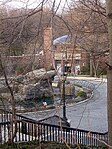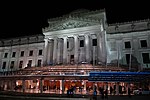Battle Pass
1770s individual tree deaths1776 in New York (state)18th century in BrooklynAC with 0 elementsBattles of the New York Campaign ... and 5 more
Individual trees in New York CityLandforms of BrooklynMountain passes of New York (state)Prospect Park (Brooklyn)Use mdy dates from July 2019

Battle Pass, formerly known as Flatbush Pass or Valley Grove or The Porte, is a historic hill pass that played a significant part in the 1776 Battle of Long Island, and that is currently part of Prospect Park in Brooklyn. Flatbush Pass went through Heights of Guan along the Native American trail Mechawanienck that preceded Kings Highway (later this section became Flatbush Road), and was at the border between the Towns of Brooklyn and Flatbush in Kings County under the Dongan Charter of November 12, 1685. Earlier, Governor Lovelace mentioned the pass in documents from 1670.
Excerpt from the Wikipedia article Battle Pass (License: CC BY-SA 3.0, Authors, Images).Battle Pass
East Drive, New York Brooklyn
Geographical coordinates (GPS) Address External links Nearby Places Show on map
Geographical coordinates (GPS)
| Latitude | Longitude |
|---|---|
| N 40.6661 ° | E -73.9665 ° |
Address
Site of the Dongan Oak (Battle Pass)
East Drive
11238 New York, Brooklyn
New York, United States
Open on Google Maps









